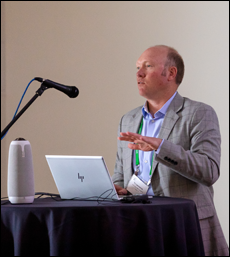Beginning at the End
WTAMU’s Ty Lawrence describes research project using cell clone technology to produce progeny from Prime, YG 1 carcass.
The most common approach to producing cattle is to choose a sire and dam based on expected progeny differences (EPDs) and phenotypic features. However, that wasn’t the case for research conducted by Ty Lawrence, professor of animal science at West Texas A&M University.

|
|
“As a meathead, I don’t look at the outward appearance of the animal quite like I used to,” said Ty Lawrence, WTAMU. “Now I look at the outward appearance of a carcass.” [Photo by Briley Richard for Angus Media] |
Lawrence, a self-proclaimed meathead, grew up on a cattle operation with his dad making choices by looking at EPDs and phenotypes. Lawrence has extensive experience in the meat science industry, leading him to begin the PrimeOne research project, a project that began with the end — a USDA Prime, Yield Grade (YG) 1 carcass.
“As a meathead, I don’t look at the outward appearance of the animal quite like I used to,” said Lawrence. “Now I look at the outward appearance of a carcass.”
On June 3, he shared the study’s origins and findings at the 2022 Beef Improvement Federation Research Symposium and Convention in Las Cruses, N.M. The PrimeOne cloning project began by using somatic cell nuclear transfer.
“You take a muscle cell and grow it in growth medium in a petri dish,” Lawrence explained. “Perfect cells are chosen, and those cells are inserted into an enucleated egg.”
Harvested from ovaries of cows at the slaughterhouse, the enucleated eggs have had their nucleus removed, Lawrence described. “The only thing remaining is the mitochondria DNA, and then we insert that one muscle cell.”
The embryos were then transferred into the recipient cow, resulting in offspring that are clones of the animal producing the Prime, YG 1 carcass. Since the birth of the offspring, four variations of research have been conducted. One of the projects is currently in the works.
These projects began from wanting to create genetic opportunities to improve beef quality and yield, improve beef production efficiency, highlight the role of technology in agriculture and provide students with unique learning opportunities.
The first data collected originated with producing offspring from the cloned bull, Alpha, and cloned heifers, Gamma. Of the seven steer progeny, one graded Prime, three graded high-Choice and three graded moderate Choice. One received a YG 1, while six were YG 2.
The researchers have also compared the performance of Alpha and the original first calf AlphaGamma1 to well-known bulls of several breeds to compare the performance of the progeny.
To watch the full presentation, which includes results of these trials, visit www.youtube.com/watch?v=HNMiSBrWUvY. To download the slides for this presentation, click here.More than 300 beef producers, academia and industry representatives attended BIF’s 54th Annual Research Symposium and Convention in Las Cruces, New Mexico. For more information about this year’s symposium, including award winners, coverage of the symposium and an archive to coverage of past conferences, go to BIFconference.com.
Editor’s note: This summary was written under contract or by staff of Angus MediaSM. To request reprint permission, please contact Shauna Hermel, Angus Beef Bulletin® editor at 816-383-5270, or Julie Mais, Angus Journal® editor, at 816-383-5271. We welcome educational venues and cattlemen to link to this site as a service to their audiences.
BIFconference.com is a meeting coverage site provided by Angus Media. For questions about this site, or to notify us of broken links, click here. Look for additional coverage in the Angus Journal, the Angus Beef Bulletin, the AJ Daily, and the Angus Beef Bulletin EXTRA.



